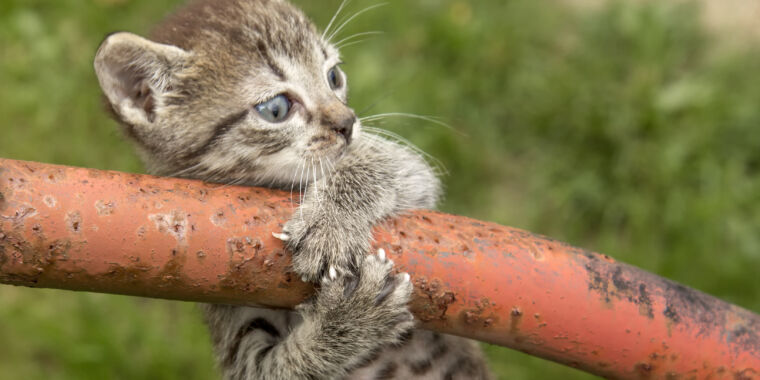
Isaac Newton would not have discovered the laws of motion if he had only studied cats.
Suppose you pick up a cat on its belly and drop it out of a second-story window. If the cat were just a mechanical system obeying Newton’s laws of matter in motion, it should land on its back. (Okay, there are some technicalities—like that this has to be done in a vacuum, but ignore that for now.) Instead, most cats typically avoid injury by twisting their way down to land on their feet.
Most people aren’t surprised by this trick—everyone has seen videos of feline acrobatics. But for more than a century, scientists have wondered about the physics behind how cats do it. Clearly, the mathematical theory that analyzes a cat’s fall as a mechanical system can’t be correct. Failure of live catsAs Nobel laureate Frank Wilczek points out in a recent research paper.
“This theory does not apply to real biological cats,” writes Wilczek, a theoretical physicist at MIT. They are not closed mechanical systems, and can “consume stored energy…and enable mechanical motion.”
But the laws of physics apply to cats—as well as to every other animal, from insects to elephants. Biology does not avoid physics; it embraces it. From friction on microscopic scales to the fluid dynamics of water and air, animals exploit physical laws to run, swim, or fly. And every other aspect of animal behavior, from breathing to shelter construction, depends in one way or another on the constraints imposed by physics, and the opportunities it allows.
“Living organisms are…systems whose actions are constrained by physics across multiple length scales and time scales,” Jennifer Reiser and colleagues write in the current issue of the journal Annual Review of Condensed Matter Physics.
While the field of animal behavior physics is still in its infancy, significant progress has been made in explaining individual behaviors, along with how these behaviors are shaped by interactions with other individuals and the environment. Aside from discovering more about how animals perform a variety of skills, such research may also lead to new physical knowledge gained by examining the abilities of animals that scientists do not yet understand.
Creatures in motion
Physics applies to animals in motion over a wide range of spatial scales. At the smallest end of the scale, attractive forces between nearby atoms enable geckos and some insects to climb walls or even walk on ceilings. At slightly larger scales, textures and structures provide adhesion for other biological gymnastics. In bird feathers, for example, tiny hooks and spines act like Velcro, holding the feathers in place to enhance lift during flight, Riser and his colleagues report.
Biological textures also aid movement by facilitating friction between animal parts and surfaces. The scales of California king snakes have a texture that allows them to glide rapidly forward, but increases friction to delay backward or sideways movement. Recent research suggests that some snakes that move sideways have apparently evolved a different texture that reduces friction in the direction of movement.
Microstructures also play an important role in how animals interact with water. For many animals, microstructures make the body “superhydrophobic”—that is, able to prevent water from penetrating. “Water droplet shedding in humid climates may be essential in animals such as birds and flying insects, where weight and stability are critical,” notes Emory’s Reiser and co-authors Chantal Nguyen, Orit Peleg, and Calvin Riska.
Water-repellent surfaces also help animals keep their skin clean. “This self-cleaning mechanism may be important to help protect the animal from threats such as skin-borne parasites and other infectious diseases,” the authors of the annual review explain. In some cases, removing foreign material from an animal’s surface may be necessary to maintain the surface properties that promote camouflage.




More Stories
Boeing May Not Be Able to Operate Starliner Before Space Station Is Destroyed
Prehistoric sea cow eaten by crocodile and shark, fossils say
UNC student to become youngest woman to cross space on Blue Origin